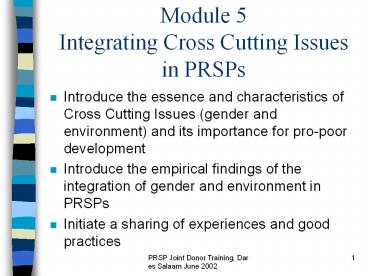Module 5 Integrating Cross Cutting Issues in PRSPs - PowerPoint PPT Presentation
1 / 17
Title:
Module 5 Integrating Cross Cutting Issues in PRSPs
Description:
PRSP Joint Donor Training, Dar es Salaam June 2002. 1. Module 5 ... PRSP Joint Donor Training, Dar es Salaam June 2002. 7. Environment in the PRSP. Where do donors ... – PowerPoint PPT presentation
Number of Views:21
Avg rating:3.0/5.0
Title: Module 5 Integrating Cross Cutting Issues in PRSPs
1
Module 5Integrating Cross Cutting Issues in PRSPs
- Introduce the essence and characteristics of
Cross Cutting Issues (gender and environment) and
its importance for pro-poor development - Introduce the empirical findings of the
integration of gender and environment in PRSPs - Initiate a sharing of experiences and good
practices
2
PROTECTIVE
Security
Vulnerability
POLITICAL
ECONOMIC
Power
Consumption
GENDER
Influence
Income
Freedom
Assets
Environment
HUMAN
SOCIO-
Health
CULTURAL
Education
Status
Fertility
Dignity
3
Cross Cutting Issues
- Globalisation and Information explosion is
increasing policy interdependency - Organisational consequences
- institutional structures, roles etc.
- Need for integration rather than coordination
- Policy implementation
- accountability procedures, participatory policy
design, continuous policy adjustment
4
Why Mainstreaming?
- Opening process to environmental/gender voices
- Gathering data on environmental/gender issues
- Analyzing environmental/gender links to poverty
- Prioritizing actions with environment/gender in
mind - Monitoring outcome with environment/gender in mind
Can the PRS process be the mechanism by which cc
issues are mainstreamed into central policy
making?
5
Environment and Poverty
- Land use
- Water
- Air
- Biodiversity and climate change
- Issues in focus
- Causal links
Who holds the knowledge? How is it communicated?
- Natural resource degradation and poverty
- Environmental health
- Vulnerability
- Property Rights
- Incentives
- Empowerment
- Gender Environment
6
Environment and PovertyPolicy Responses
- Environmental management capacity
- Investment in natural capital
- Investment in man made capital
- Monitoring the natural resource outcomes
- Monitoring the human resource outcomes
7
Environment in the PRSP
Where do donors come in and how?
8
Environment and PovertyIntegration in PRSPs
- Review of 40 PRSPs by WB Environment Department
(Bojö/Reddy) - Assessment based on 17 criteria
- Problems opportunities described
- Poverty-environment links analyzed
- Environmentally relevant actions
- Ranking from 0 to 3
9
Environment and PovertyIntegration in PRSPs
- Considerable variation across countries
- Low average score
- Full PRSPs ranking better than I-PRSPs
- Good practices do exist
10
Gender and Poverty
- Direct links
- access to security
- access to resources
- access to opportunities
- Indirect links
- social, economic and political organisation
affecting knowledge and participation in public
processes - Sectoral dimensions
- agriculture, credit, education, health, urban
development, ...
11
Gender and Poverty
- Rationale for integrating gender
- equity
- women have higher mortality rates
- women work longer
- women are generally underrepresented
- women have lower access to resources
- efficiency
- women's reduced contribution to production/income
hinders economic growth and poverty reduction
12
Gender in the PRSP
13
Gender and Poverty Integration in PRSPs
- The World Bank Gender Division investigated 19
PRSPs (15 Interim and 4 full) - Looks at
- Gender and the consultation process
- Gender and Poverty Diagnosis
- Gender and Public Action
- Gender and targets/monitoring
14
Gender and Poverty Integration in PRSPs
15
Gender and Poverty Integration in PRSPs
16
What about National Ownership?
- We have agreed within DAC
- Issues of substantial importance to development
agency constituencies must be integrated into
policy dialogue without imposing an
externally-driven agenda - Genuine dialogue between central government and
other parts of society should be facilitated in
ways that do not undermine the legitimacy of
partners governments, the role of parliament and
other key democratic institutions - Development effectiveness strengthens the need
for a more selective, more strategic approach to
aid allocations
17
Questions for reflection
- 1. Can ordinary women, men and youth own the PRS
and commit to its implementation? - 2. Can gender be mainstreamed in such a manner
that gender is treated as a variable for
development? - 3. How can donors play a key role in integrating
gender in PRS?































